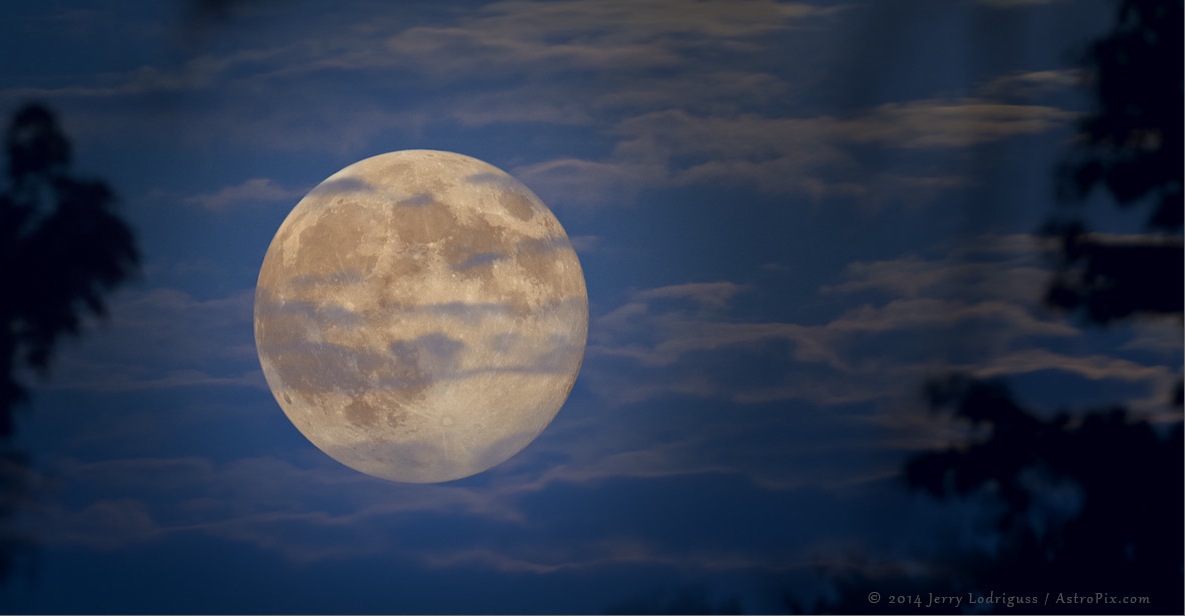
by Somya Devi | Oct 24, 2015 | Astrology, Conjunctions, Planets Changing Signs
The Moon will be at its fullest on Monday night! Tuesday, October 27th brings the peak of the full Moon in Ashwini nakshatra at 5:05am PDT. Ashwini is the first constellation in the order of the zodiac, comprised of the two bright stars Hamal (alpha arietis) and Sheratan (beta arietis) on the side of Aries closest to Pisces. Ashwini refers to a horse-woman and carries horse-power with it. In it lies the energy we require to get moving and power through things. We may feel a sudden burst of energy around this full Moon, and can attempt to harness that power towards our goals and the new direction we’ve found after emerging from the transitions of the recent eclipse cycle.
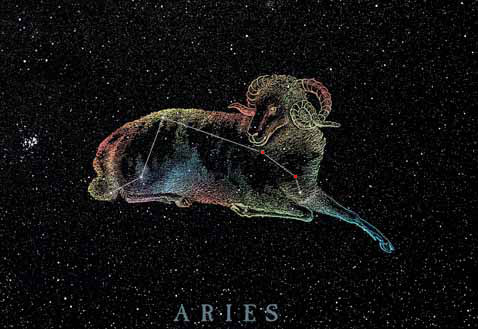 The deities for this star are the Ashwin Kumars, the divine physicians, and this full Moon brings their great healing potential. This cycle began with Sun and Moon in Chitra, related to Vishvakarma, the celestial architect who inspires creativity and perfecting the structures we create. With the full Moon in Ashwini, we can call upon the celestial physicians to help heal and strengthen the places we need divine medicine to move forward in strength on our creative journey. These juices flow from deep within you, and now is a chance to get in touch with your self-healing potential.
The deities for this star are the Ashwin Kumars, the divine physicians, and this full Moon brings their great healing potential. This cycle began with Sun and Moon in Chitra, related to Vishvakarma, the celestial architect who inspires creativity and perfecting the structures we create. With the full Moon in Ashwini, we can call upon the celestial physicians to help heal and strengthen the places we need divine medicine to move forward in strength on our creative journey. These juices flow from deep within you, and now is a chance to get in touch with your self-healing potential.
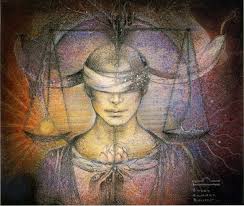 It’s a fortunate time for this opportunity, because there are a few factors that may have been making us feel spread a little thin this month. The Sun, the planet of our vitality and inner power, entered his sign of debilitation (Libra) on October 17th. When Sun is in Libra we tend to place more emphasis on trying to please others and balance relationships than we do on taking care of ourselves. Sun in Libra can fashion us the peacemaker, trying to negotiate a good deal for everyone else but sometimes forgetting about our own self-care regimen.
It’s a fortunate time for this opportunity, because there are a few factors that may have been making us feel spread a little thin this month. The Sun, the planet of our vitality and inner power, entered his sign of debilitation (Libra) on October 17th. When Sun is in Libra we tend to place more emphasis on trying to please others and balance relationships than we do on taking care of ourselves. Sun in Libra can fashion us the peacemaker, trying to negotiate a good deal for everyone else but sometimes forgetting about our own self-care regimen.
Furthermore, Sun will be in the nakshatra called Swati during this full Moon, which is a place in the sky that often scatters everything like the wind. Try to center your energy before taking big strides, and hold tight to the reins (through focus and practice) so the horse-power of Ashwini doesn’t pull you astray. On top of this, vata dosha (cold, dry, and windy) naturally increases during fall and winter, so in the northern hemisphere we are facing increasing vata, which can also make us feel scattered and depleted. With all of these factors, be sure to take the time to care for yourself this month. It’s a good time to start bundling up and nourishing yourself with warm soups, cozy baths, and moisturizing oils. The full Moon in Aries will remind us of how we feel about our personal strength, so it will be a good time to check in and reconnect with your own health and well-being, while calling upon the healing energies of Ashwini.
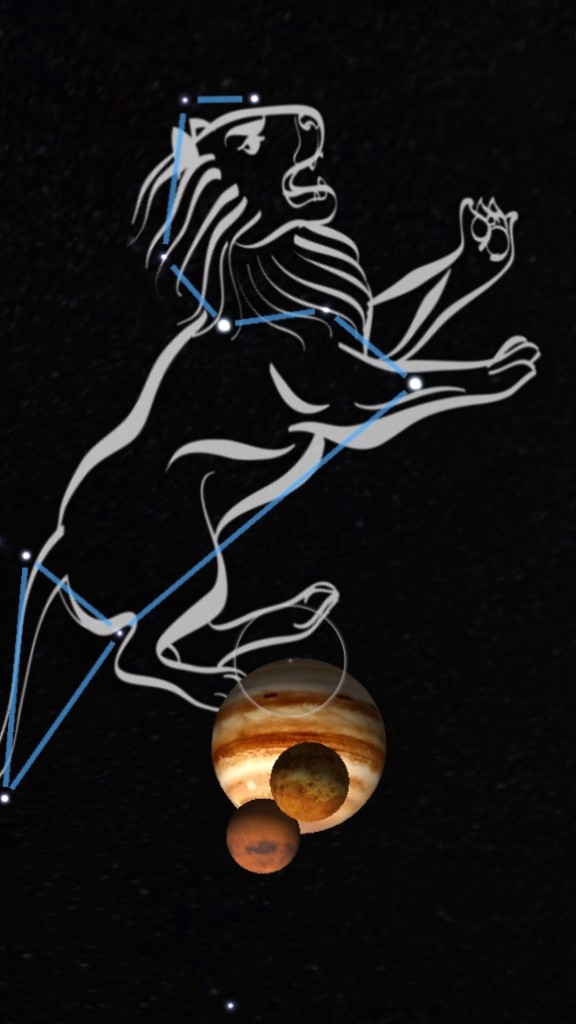 We may also be feeling inspired as well as overwhelmed by the pile-up of planets in sidereal Leo–Jupiter, Mars, and Venus. These three are conjunct this month, which amps up the energy we feel behind our philosophies, will, and desires. We can see this bright cluster on the eastern horizon just before sunrise. The confluence of these planetary energies can support each other if we do the work needed to introspect and synthesize them towards our highest purpose, but they can also be at odds with each other when the planets get too close for comfort (within one degree celestial longitude).
We may also be feeling inspired as well as overwhelmed by the pile-up of planets in sidereal Leo–Jupiter, Mars, and Venus. These three are conjunct this month, which amps up the energy we feel behind our philosophies, will, and desires. We can see this bright cluster on the eastern horizon just before sunrise. The confluence of these planetary energies can support each other if we do the work needed to introspect and synthesize them towards our highest purpose, but they can also be at odds with each other when the planets get too close for comfort (within one degree celestial longitude).
For example, on October 15th-17th Mars and Jupiter were so close that we may have faced some blow-ups over our philosophies. If our actions weren’t totally in line with our values, there might have been explosive shifts to help propel us into alignment. October 24th-26th brings a tight conjunction of Venus and Jupiter, which could bring up a discrepancy between our values and our relationships and pleasurable pursuits. We could be facing some tough choices about compromising. October 31st-November 3rd, Mars and Venus are closely conjunct, which will pin our individual will against our ability to compromise. It could be a pivotal time for healing relationships and moving forward. The three planets are in Purva Phalguni nakshatra during this full Moon, which brings the energies of relaxation and rejuvenation. With all of these planets in Leo, the fiery sign of the Sun, we have the opportunity to purify ourselves and clean up our energies so that we feel totally oriented in the right direction in all areas of life. On the night of November 2nd both Mars and Venus will enter Virgo (where Venus is debilitated), joining Rahu, which could make us face romance in a more practical, analytical way, but could also intensify our desires.
During the full Moon in Ashwini nakshatra on October 27th, give thanks to the divine physicians and bask in the healing energy of the Moon!
Don’t forget to change clocks back in the U.S. on November 1st!
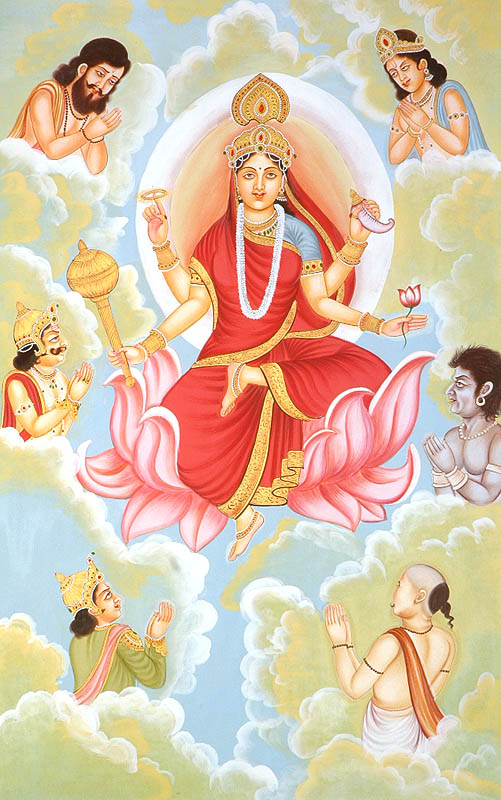
by Somya Devi | Oct 21, 2015 | Astrology, Holy Days
The ninth day of Navaratri is of utmost importance, and is marked by shukla navami, the ninth tithi (lunar phase) of the waxing Moon this month. On this day we honor Goddess as Siddhidatri, the giver of all siddhis, special powers or perfect attainments. Siddhis are magical, spiritual, or psychic powers, attained through dedication and devoted practice. Through worship and meditation upon all the forms of Durga, culminating with that of Siddhidatri, we can attain perfection and infinite blessings from her. Through the siddhis, all desires can be fulfilled. It is often said that the greatest blessing one can receive is to transcend all desires, or to have one’s only desire be to know Goddess/God.
With the blessing of devotion, through her grace, we can remain peaceful and happy in all circumstances, blissfully experiencing the Divine Mother’s presence in and throughout all of creation, in every moment. In this way the ninth day of Navaratri also relates to the illuminating wisdom of Sarasvati, who is often worshiped over the last three days of this festival.
In her depiction, Siddhidatri sits on a lotus or a lion and holds a discus (representative of the chakras), a lotus, a mace, and conch shell, which she will use to sound the victory we attain through her worship. She is surrounded by and worshiped by all forms of divine beings–Gods, demons, spiritual masters and nature-spirits. It is said that even Lord Shiva received his powers from Siddhidatri. In the divine form that is half Shiva and half Shakti, he is merged with Siddhidatri and known as Ardhanarishvara.
Siddhidatri relates to Ketu (the south node of the Moon), and thus she governs our deep and ancient psychic wisdom. She is a powerful goddess to worship for enhancing spiritual, psychic and energetic healing powers.
Full Article on Navaratri 2017
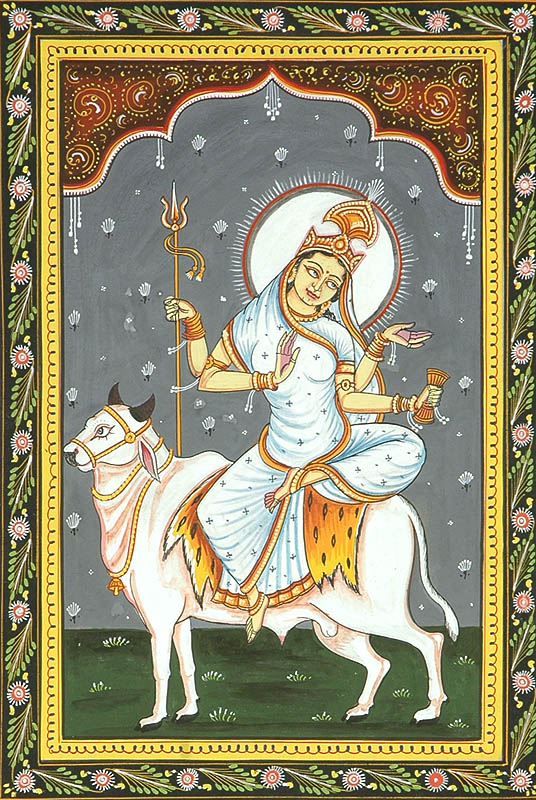
by Somya Devi | Oct 20, 2015 | Astrology, Holy Days
Shukla ashtami, the eighth tithi (lunar phase) of the waxing Moon this month, marks the eighth day of Navaratri during which we honor Goddess as Mahagauri, the “great white” goddess. This incarnation of Durga is fair, shining and radiant like pure light, representing her purifying shakti. She rides a bull and carries a damaru (a hand-drum) and a trisul in two hands, keeping the other two in mudras for blessing and protecting. She represents compassion, truth, and purity and bestows these on her devotees. Mahagauri is often thought of as the young form of Parvati, and thus worshipers often feed young girls sweets on this day of celebration, to honor the great white goddess.
The story is often told that while Parvati was doing penance to win Lord Shiva, her body became black and dirty. When Shiva accepted her he washed her with the water of the Ganga which made her shine resplendently and become Mahagauri. This represents her power to free us from all pain and suffering and to bless us with auspiciousness and virtues, as those who bathe in the waters of the holy river Ganga are said to be blessed and purified. This includes freeing us from the painful attachments to the material world. As we worship Mahagauri after the night of worship dedicated to Kalaratri, we can see that this detachment and reemergence into the light can come only after facing death and darkness.
This goddess relates to the planetary deity Rahu (the north node of the Moon), who is actually a shadow point in the cosmos and has no physical body. Thus Mahagauri relates to parts of our soul and psyche that are beyond the physical body or chakra system. In our worship, making offerings to her and meditating upon her, we can begin to go beyond our attachments to the mundane details of life and brighten our awareness of spirit.
Full Article for Navaratri 2017
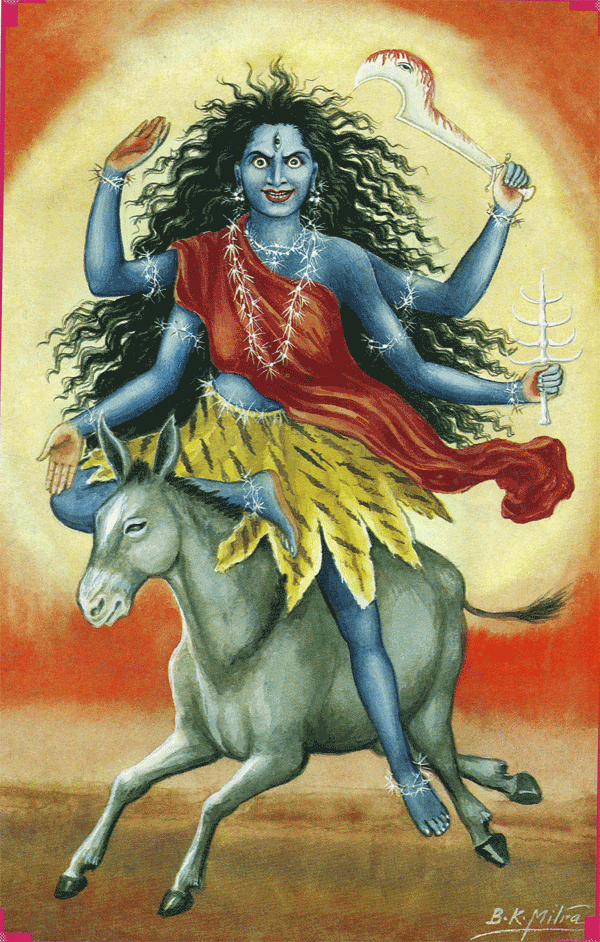
by Somya Devi | Oct 19, 2015 | Astrology, Holy Days
Shukla sapthami, the seventh tithi (lunar phase) of the waxing Moon this month, marks the seventh day of Navaratri wherein we honor Goddess as Kalaratri, a dark and fierce form of Durga. She has wild black hair, dark complexion, three red eyes, and flaming nostrils. She rides a donkey, and carries a sword and a cleaver in two hands, while her two other hands are in mudras offering blessings and protection.
“Kala” refers to time, darkness, and therefore death. “Ratri” is night, and the presence of this goddess signifies a night of facing death and darkness. She reminds us that these are parts of the experience of life. By facing these aspects, and by worshiping Kalaratri, we can be freed from the pain and suffering associated with them. She is by our side bravely and compassionately as we face the morbid and terrifying aspects of existence, and helps to destroy our fears and weaknesses, giving us great strength.
She is an expression of Kali, whose fearful form was birthed from Durga’s third eye when Durga needed more strength and ferocity to fight the demon Raktabija. She is also called Shubhankari, she who does auspicious deeds, and reminds us that we have nothing to fear from her, and nothing to fear, ever. The compassionate energy of the Divine Mother is always working through all parts of creation, even in the processes of destruction. Kalaratri rules Saturn (Shani), who also represents time and ultimate death, and offers us the opportunity for expanded consciousness through meditation on this inevitability. By worshiping Kalaratri on the seventh day of Navaratri and meditating on her deeply, we connect with the sahasrara (crown) chakra, and the barriers between mind, body, and spirit begin to dissolve. She blesses us with happiness and courage, helping to remove sadness, pain, and fear.
In some areas, the seventh day of Navaratri begins the worship of Sarasvati. Having worshiped Durga and Lakshmi for three days and nights each, to remove obstacles and obtain spiritual wealth. Now the devotee is ready to receive knowledge, which comes from Sarasvati, the goddess of learning. In other schools of worship, such as Kalikula in Nepal, Sarasvati is celebrated for the first three nights, followed by Lakshmi, and the last three nights are dedicated to Kali.
Full Article on Navaratri 2017
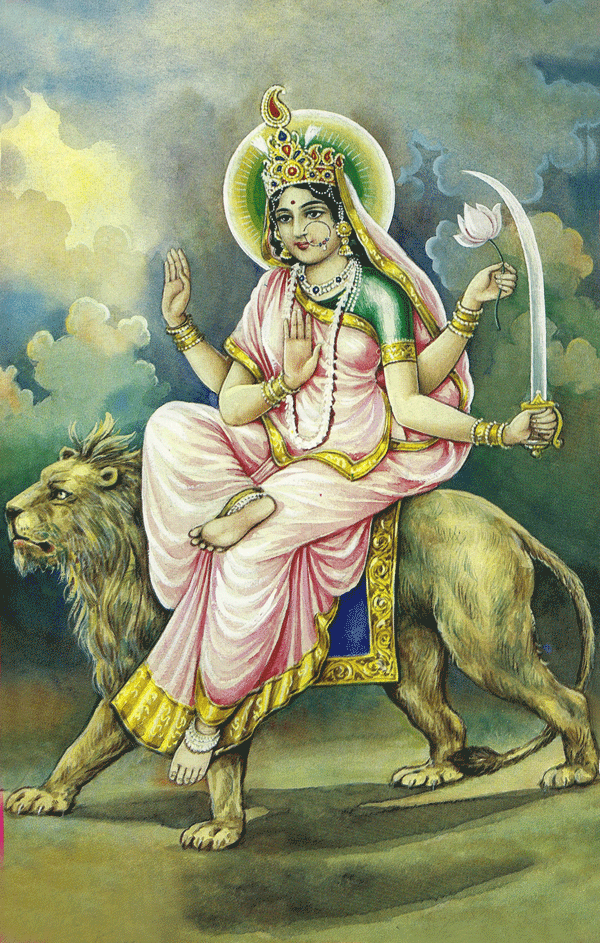
by Somya Devi | Oct 18, 2015 | Astrology, Holy Days
Shukla shashthi, the sixth tithi (lunar phase) of the waxing Moon this month, marks the sixth day of Navaratri wherein we celebrate Goddess in the form of Katyayani, the warrioress who destroyed Mahishasura (the buffalo demon). Mahishasura had been granted a boon (unbreakable wish) from Lord Brahma that determined that no man could kill him. Thus, when he was terrorizing the earth and heavens, the Gods summoned Goddess Durga to come and save them. This form of Durga is named Katyayani, for her father Katya, a devoted sage who did rigorous penance in order to have Durga take birth as his daughter.
Katyayani takes a fierce form of the Divine Mother when we call upon her to destroy our demons, including both internal negativities and external obstacles to material and spiritual success. She relates to the ajna (the third-eye) chakra, where we draw our concentration during worship today.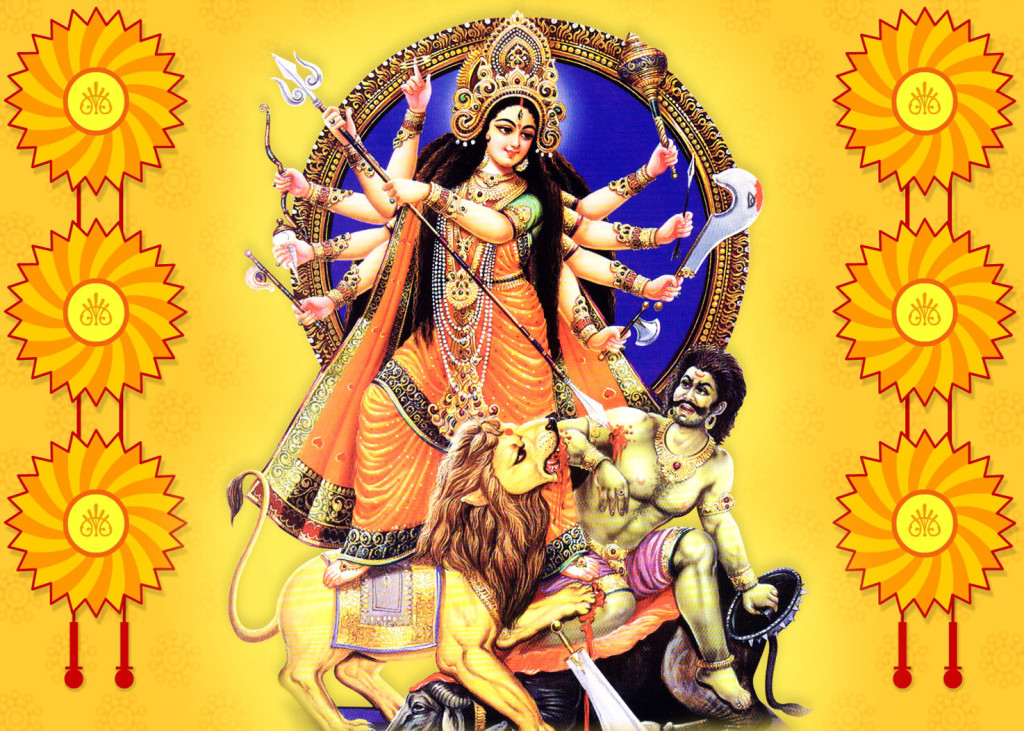 Katyayani relates to fervent devotion, and it is told that she was also worshipped by the Gopis of Vrindavan, who called on her to help them win Lord Krishna as their husband.
Katyayani relates to fervent devotion, and it is told that she was also worshipped by the Gopis of Vrindavan, who called on her to help them win Lord Krishna as their husband.
It is said that worshiping Katyayani will help in bringing a good relationship and marriage, as she bestows the strength to remove obstacles. She also rules Jupiter (Guru), who represents husband in a woman’s astrological chart. Jupiter brings grace, expansion, and optimism, just as Katyayani helps us to fight sorrow and fear. Katyayani is related to fragrances, and offering her incense and other aromatics is a good practice to include in worship today. Through healing scents she helps us to fight disease and improve health. She holds both a lotus and a sword in two of her hands, and holds the other two in mudras offering protection and blessings.
Full Article on Navaratri 2017
Full Save
Save
Save
Save

 The deities for this star are the Ashwin Kumars, the divine physicians, and this full Moon brings their great healing potential. This cycle began with Sun and Moon in Chitra, related to Vishvakarma, the celestial architect who inspires creativity and perfecting the structures we create. With the full Moon in Ashwini, we can call upon the celestial physicians to help heal and strengthen the places we need divine medicine to move forward in strength on our creative journey. These juices flow from deep within you, and now is a chance to get in touch with your self-healing potential.
The deities for this star are the Ashwin Kumars, the divine physicians, and this full Moon brings their great healing potential. This cycle began with Sun and Moon in Chitra, related to Vishvakarma, the celestial architect who inspires creativity and perfecting the structures we create. With the full Moon in Ashwini, we can call upon the celestial physicians to help heal and strengthen the places we need divine medicine to move forward in strength on our creative journey. These juices flow from deep within you, and now is a chance to get in touch with your self-healing potential. It’s a fortunate time for this opportunity, because there are a few factors that may have been making us feel spread a little thin this month. The Sun, the planet of our vitality and inner power, entered his sign of debilitation (Libra) on October 17th. When Sun is in Libra we tend to place more emphasis on trying to please others and balance relationships than we do on taking care of ourselves. Sun in Libra can fashion us the peacemaker, trying to negotiate a good deal for everyone else but sometimes forgetting about our own self-care regimen.
It’s a fortunate time for this opportunity, because there are a few factors that may have been making us feel spread a little thin this month. The Sun, the planet of our vitality and inner power, entered his sign of debilitation (Libra) on October 17th. When Sun is in Libra we tend to place more emphasis on trying to please others and balance relationships than we do on taking care of ourselves. Sun in Libra can fashion us the peacemaker, trying to negotiate a good deal for everyone else but sometimes forgetting about our own self-care regimen. We may also be feeling inspired as well as overwhelmed by the pile-up of planets in sidereal Leo–Jupiter, Mars, and Venus. These three are conjunct this month, which amps up the energy we feel behind our philosophies, will, and desires. We can see this bright cluster on the eastern horizon just before sunrise. The confluence of these planetary energies can support each other if we do the work needed to introspect and synthesize them towards our highest purpose, but they can also be at odds with each other when the planets get too close for comfort (within one degree celestial longitude).
We may also be feeling inspired as well as overwhelmed by the pile-up of planets in sidereal Leo–Jupiter, Mars, and Venus. These three are conjunct this month, which amps up the energy we feel behind our philosophies, will, and desires. We can see this bright cluster on the eastern horizon just before sunrise. The confluence of these planetary energies can support each other if we do the work needed to introspect and synthesize them towards our highest purpose, but they can also be at odds with each other when the planets get too close for comfort (within one degree celestial longitude).




